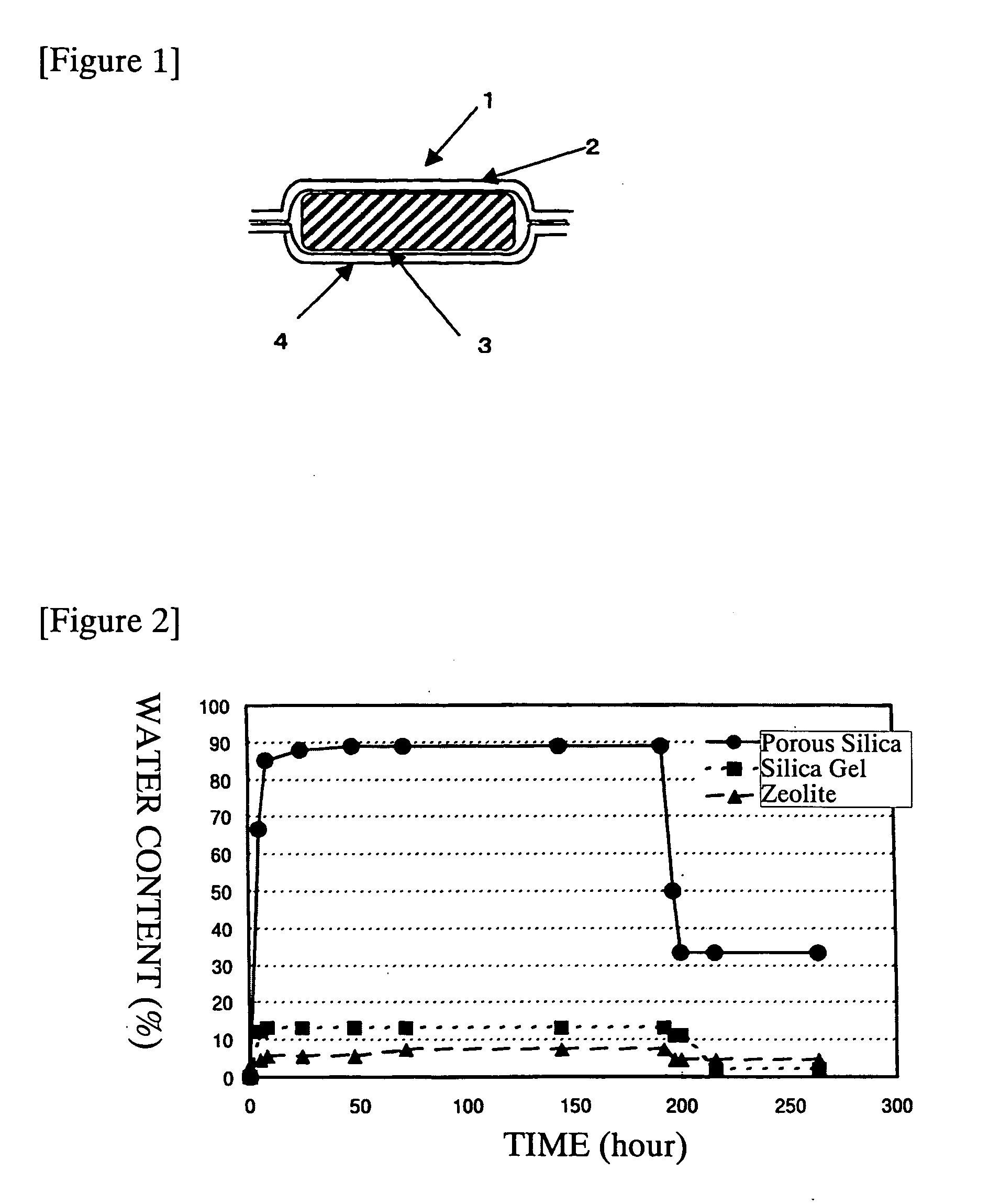Adsorptivity imparting agent containing porous silica
a technology of imparting agent and porous silica, which is applied in the direction of packaging goods, alkali metal oxide/hydroxide, containers for heating food, etc., can solve the problems of affecting the taste of foods, etc., to prevent hands, ovens, clothes and the like from being soiled, and high adsorption and desorption
- Summary
- Abstract
- Description
- Claims
- Application Information
AI Technical Summary
Benefits of technology
Problems solved by technology
Method used
Image
Examples
embodiment 1
Food Wrapping Materials
[0139] The food wrapping material of this embodiment contains the above-mentioned imparting agent.
[0140] The porous silica used in this embodiment has pores having an average pore size of preferably from 1 to 10 nm, and more preferably from 2 to 5 nm, from the viewpoint of miscibility with other raw materials.
[0141] The porous silica used in this embodiment has a pore volume of preferably from 0.2 to 2.0 cm3 / g, from the viewpoint of adsorption efficiency of moisture or oil.
[0142] The porous silica used in this embodiment has a specific surface area of preferably from 400 to 1500 m2 / g, and more preferably from 600 to 1200 m2 / g, from the viewpoint of adsorption efficiency of moisture or oil.
[0143] The porous silica used in this embodiment has an average particle size of preferably from 50 nm to 10 μm, more preferably from 50 to 500 nm, and even more preferably from 50 to 300 nm, from the viewpoint of adsorption efficiency of moisture or oil.
[0144] The food...
embodiment 2
Filtration Aid
[0152] The filtration aid of this embodiment contains the above-mentioned imparting agent.
[0153] The porous silica used in this embodiment has pores having an average pore size of more preferably from 1 to 10 nm, and more preferably from 2 to 5 nm, from the viewpoint of adsorbing a specified protein which is causative of grout.
[0154] The porous silica used in this embodiment has a pore volume of preferably from 0.2 to 2.0 cm3 / g, more preferably from 0.5 to 2.0 cm3 / g, and even more preferably from 0.8 to 2.0 cm3 / g, from the viewpoint of adsorption volume.
[0155] The porous silica used in this embodiment has a specific surface area of preferably from 400 to 1500 m2 / g, more preferably from 600 to 1200 m2 / g, and even more preferably from 800 to 1200 m2 / g, from the viewpoint of adsorption volume.
[0156] The porous silica used in this embodiment has an average particle size of preferably from 50 nm to 10 μm, more preferably from 50 to 500 nm, and even more preferably from...
embodiment 3
Sanitary Article
[0160] The sanitary article of this embodiment contains the above-mentioned imparting agent.
[0161] The porous silica used in this embodiment has pores having an average pore size of preferably from 1 to 10 nm, and more preferably from 2 to 5 nm.
[0162] The porous silica used in this embodiment has a pore volume of preferably from 0.2 to 2.0 cm3 / g, from the viewpoint of adsorption volume.
[0163] The porous silica used in this embodiment has a specific surface area of preferably from 400 to 1500 m2 / g, and more preferably from 600 to 1200 m2 / g , from the viewpoint of adsorption volume.
[0164] The porous silica used in this embodiment has a specific surface area of preferably from 50 nm to 10 μm, more preferably from 50 to 500 nm, and even more preferably from 50 to 300 nm.
[0165] The sanitary article in this embodiment is not particularly limited. The sanitary article includes, for example, sanitary napkins, disposable diapers, incontinence pads, panty liners, sheet f...
PUM
| Property | Measurement | Unit |
|---|---|---|
| Length | aaaaa | aaaaa |
| Fraction | aaaaa | aaaaa |
| Mass | aaaaa | aaaaa |
Abstract
Description
Claims
Application Information
 Login to View More
Login to View More - R&D
- Intellectual Property
- Life Sciences
- Materials
- Tech Scout
- Unparalleled Data Quality
- Higher Quality Content
- 60% Fewer Hallucinations
Browse by: Latest US Patents, China's latest patents, Technical Efficacy Thesaurus, Application Domain, Technology Topic, Popular Technical Reports.
© 2025 PatSnap. All rights reserved.Legal|Privacy policy|Modern Slavery Act Transparency Statement|Sitemap|About US| Contact US: help@patsnap.com

